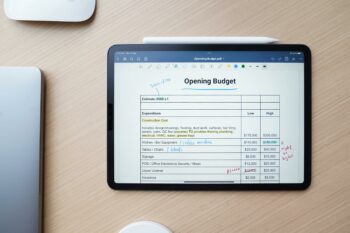Guide to National Insurance for Employers
Nov 2022
It’s another portion of time that employers have to dedicate to their payroll duties, but what exactly does it involve?
National insurance for employers is just another facet of payroll. It’s a dreary and quite often thankless task but it is part of the essentials of running a business or launching a startup.
It is a drag, we know. You run your business with the aim of becoming a success, the passion for your chosen industry and the desire to scale up. Rare are the entrepreneurs who look forward to a fun filled day of organising payroll.
And yet, it must be done.
But when it comes to National Insurance, employers have very stringent requirements that they must meet. You must organise the payroll and national insurance on behalf of your employees, but where do you start?
Well, you’ll start right here. Let’s explore national insurance for employers and cover everything you wanted to know about it but were too bored to ask.

What is National Insurance?
National Insurance is a scheme in the United Kingdom designed to work for the benefit of both the state and individuals.
It is primarily used to fund state benefits, such as the National Health Service, state pensions and other such societal obligations. While National Insurance Contributions (NICs) are made by both employees and employers, self-employed people also must make their own contributions, provided they earn enough, but more about that later!
There are different rates of contribution for employees and employers, and the amount that self-employed people pay depends on their profits. In general, those who earn more money pay higher rates of National Insurance. There are also some exemptions and discounts available. For example, certain categories of employees are not required to pay National Insurance, such as apprentices and some types of interns. In addition, people who are over the state pension age do not have to make any National Insurance contributions.
Employers are required to deduct National Insurance contributions from their employees' wages before they pay them. This is the opposite to self employed people who have to fill out yearly self assessments or quarterly updates with the Making Tax Digital scheme.
Essentially, Employee NI contributions are taken out of their earnings, whereas employer NI contributions are paid on top of their earnings.
Different National Insurance Classes
There are 4(ish) different classes of national insurance. These are:
Class 1 - National Insurance Contributions paid by Employers and Employees
Class 2 - National Insurance Contributions paid weekly by self employed individuals
Class 3 - Voluntary National Insurance Contributions from individuals that wish to cover gaps in their employment record
Class 4 - National Insurance Contributions paid by self employed individuals on a portion of their profits
Obviously, since you are here, we'll focus on Class 1 as it revolves around national Insurance for employers and employees.
The reason why we said 4ish is because Class 1 NICs actually have another two separate categories. These are:
1A - National Insurance Contributions on taxable benefits and expenses
1B - Employer only National Insurance Contributions if an employee has a PAYE Settlement Agreement (PSA) on any items included within the PSA that would otherwise fall under class 1 or 1A NICS.
In short, you’ll pay Class 1 and 1A contributions unless any of your employees have a PSA agreement, in which case, you’ll pay some Class 1B contributions.
Following so far?

Why do employers pay National Insurance?
National insurance is a form of social security that helps to provide financial protection for workers in the event of illness, injury, unemployment, or retirement. As a result, employers who pay national insurance are not only helping to protect their employees, but they are also playing a vital role in funding important public services.
But why is it the employer’s responsibility?
Well, for starters, HMRC has an incredible job to do as it is. As a wealthy and very productive country the UK has hordes of companies, workforces and employees as a result. So the onus of putting NICs under employer payroll cuts down a great deal of chasing down.
But it’s also for you, the employer.
You pay NICs on not only the profit you make, but the various benefits and expenses written down by your careful bookkeepers along the way. You need all of those detailed little bits of information in order to calculate your employer NICs precisely!
By taking care of NICs as you complete your payroll, you have all the knowledge necessary to fulfil your employer tax obligations. You’ll have no need to avoid a tax audit if you know that all the books are perfectly clear!
Create a brand story for your startup
National Insurance category letters
Each employee can fall under a different national insurance category. This is different to the National Insurance tax brackets which we will cover in full further below. For the majority of your employees you will have absolutely no need to worry about their tax category as they fall under category A.
However, you (or your bookkeeping services) should be aware of other potential categories:
- Category B
Married women or widows who are working and entitled to pay reduced National Insurance Contributions.
- Category C
Employees who are over the state pension age.
- Category J
Employees who defer NICs because they pay them through another job (such as self employment)
- Category H
Apprentices under the age of 25
- Category M
Employees under the age of 21
- Category Z
Employees who are under the age of 21 but pay National Insurance Contributions through another job

National Insurance thresholds
There are different National Insurance thresholds that are presented on either a weekly or a monthly basis. These offer different limitations and classifications depending upon how much each employee earns.
These thresholds are mutable. For example, the lower earnings limit from July 2022 to April 2023 is £533, whereas in the tax year of 2019/2020 it was £512. Staying on top of the UK’s changing tax laws is a vital job of your bookkeeping services.
These values are correct at the time of writing up until April 2023.
Lower earnings limit
The LEL is currently set at £533 every month. At the LEL, employees do NOT pay National Insurance Contributions, but still receive the benefits of paying.
Primary threshold
This is set at £1048 every month, and it is at this level of earnings that employees start paying National Insurance Contributions. Or rather, you as the employer start paying those NICs for them.
Secondary threshold
The secondary threshold is actually lower than the primary threshold and it is for a very important reason. Once employees exceed the secondary threshold of £758 a month, that’s when you, the employer, start paying National insurance.
Upper earnings limit
Set at £4189, the upper earnings limit is the maximum at which an employee can be paid, and can still enjoy lower rates of National Insurance Contributions.
Upper secondary threshold
Handily, it’s the same value as the Upper Earnings Limit (for now). At £4189, employers of employees who are under 21 and earn up to this wage ,pay zero rate.
Apprentice upper secondary threshold
This is set, once again, at £4189 and it is up to this level, that employers of certain apprentices who are under the age of 25 pay zero rate.
Freeports upper secondary threshold
The FUST is set at £2083. This is the maximum point at which employers of employees who work in a freeport site pay zero rate.
Veterans upper secondary threshold
Set once again at £4189, the VUST is the maximum limit where employers pay zero rate on the earnings of qualifying employees.

Employee and employer National Insurance rates
So, up until this point we have discussed the different exceptions to National Insurance Contributions, and the various earnings at which National Insurance Contributions are increased or decreased. We have also said that employers not only deduct NICs from employee’s wages, but also pay National Insurance Contributions for the business depending upon how much their employees earn.
Now let’s look at how much those will actually be.
National Insurances rates for employers
As you saw in the previous section, employers will have to pay their own National Insurance Contributions on earnings of employers above certain thresholds. All of the following values are correct for the dates between the 6th November 2022 and 5th April 2023.
Pay Rate of Employee | Employer NIC Rate |
Above the secondary threshold | 13.8% |
Below the upper secondary threshold | 0% |
Below apprentice upper secondary threshold | 0% |
NIC Class 1A contributions on benefits and expenses | 13.53% |
The class 1A contributions are placed within the table because this is an annualised charge.
National Insurance rates for employees
This is the table that you need when it comes to organising your payroll. These values are how much you deduct from employee gross pay in order to cover their National Insurance Contributions.
From 6th November 2022 to 5th April 2023, these are the National Insurance Rates for Employees:
Pay Rate of Employee | NIC Contribution |
Between primary threshold and upper earnings limit | 12% |
Above upper earnings limit | 2% |
Married women’s reduced rate between primary threshold and upper earnings limit | 5.85% |
Employees who defer National Insurance | 2% |
NI deadlines & documents that employers should know
For primary and secondary National Insurance Contributions, you must pay them monthly (or quarterly if appropriate) directly to HMRC. This is the bare basics of payroll management and it isn’t an option, it’s a necessity.
With that said, you must also organise your 1A and 1B contributions on time and with specific documents.
Class 1A contributions relating to expenses and benefits must be completed on form P11D(b) and submitted to HMRC by the 6th July following the end of the tax year.
The deadline for payment of these Class 1A contributions is 19th of July unless you are paying electronically (and who isn’t these days), in which case the deadline is 22nd of July.
Class B, as we have already discussed, is only applicable to items within any PAYE settlement agreements that your employees have agreed to. The deadline of this payment is the 19th of October following the tax year unless you’re in the 21st century paying electronically, in which case the deadline is 22nd of October instead.
Following that, after the end of each tax year, but before the 31st of May, you must provide each employee with a P60, showing their National Insurance Contributions.

Reducing your employer NICs
The Employment Allowance is a government initiative that helps small businesses by reducing their national insurance (NICs) bill. This is a valuable scheme that can help small businesses to reduce their costs and invest in growth.
Under the scheme, employers can claim back up to £5,000 per year against their NICs liability. This can be a significant saving for small businesses, which often have tight margins.
The £5000 allowance goes towards your business NICs and continues until it runs out, at which point you will have to pay your National Insurance Contributions as normal. You can check your eligibility here.
Help with National Insurance for employers
Taxes, such as your Income Tax and NICs, are easily handled with online accounting services. It’s amazing what you can receive in a complete bundle. In just one software you can receive:
Automated bookkeeping software
Report Compilations
Payroll Manager
Spending Insights
Forecasting
Budgeting
Financial Reporting
R&D Claim Builder
And much more available at a single keystroke!
This is exactly what startup Beam chose to do. With the support of online accounting services handling their taxes and payroll, they could focus their efforts on growing a burgeoning business, and now they are one of our success stories.
“TAC has been a responsive and high-quality accounting partner who truly understand the needs of startups, from the day-to-day to more strategic advice.”
Gain the financial support that your startup needs all in one place. At a fraction of the cost of an in house team, this investment is scalable and sets your business up for startling growth. Get in contact with an accountancy specialist today and remember to visit our School of Startups. It’s a comprehensive database with everything a Startup needs to know!
#1 finance partner for tech & e-commerce startups
- 100% online
- All in one accountancy, R&D and CFO services
- 9/10 customers recommend us

Educational content just for startups. As a member, you’ll get unlimited access to an extensive range of guides, blogs and advice to help you run and grow your business.


